Start Licensing’s Ian Downes is back at Olympia for Top Drawer this week and spots some great examples of licensing on show.
This week I visited the Top Drawer trade show at Olympia. It was the third trade show I have attended in the last few weeks – a real sign that things are getting back into some sort of normal routine. A further indication of a return to normality was that I had to queue to get in to the show. Once I got into the show there was a genuine buzz around and the aisles were busy, so much so that I had to remember how to do the trade show sidestep.
One thing I quickly noticed was that a couple of licensees, Half Moon Bay and Hype, that I had seen at the Spring Fair were exhibiting at Top Drawer. I was a little surprised by this so asked Richard Ford at Hype the thinking behind doing two trade shows so close together. Richard pointed out that they were able to reach and meet different retailers at the two shows. This may be explained by geography and also the type of retailer that attends the two shows. Encouragingly Hype reported good interest in its licensed cards at Top Drawer and the two show strategy seemed to be paying off.
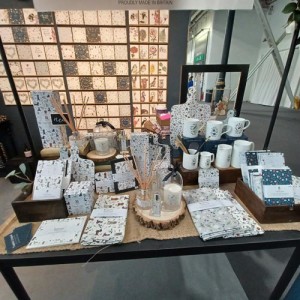 There were some great examples of licensing on show at Top Drawer. One range that I thought was noteworthy was Toasted Crumpet’s National Trust greeting cards and stationery range. The range included shopping list pads and note books, plus an extensive range of cards. Design wise the range had charming images of flowers, insects and dogs. It has a very distinctive style. I understand the range started out as one that was exclusively sold through National Trust outlets, but has grown into a range that is now in broad distribution.
There were some great examples of licensing on show at Top Drawer. One range that I thought was noteworthy was Toasted Crumpet’s National Trust greeting cards and stationery range. The range included shopping list pads and note books, plus an extensive range of cards. Design wise the range had charming images of flowers, insects and dogs. It has a very distinctive style. I understand the range started out as one that was exclusively sold through National Trust outlets, but has grown into a range that is now in broad distribution.
For the National Trust, having the chance to trial ranges in its own retail channel is a useful tool, but it is also one that I am sure is attractive to artists and publishers. The Toasted Crumpet range stands out and has a clear identity when compared to other National Trust ranges, which helps the National Trust extend its reach in the market. This range would fit well into a variety of retailers including non-traditional card and stationery retailers, plus the likes of garden centres and farm shops.
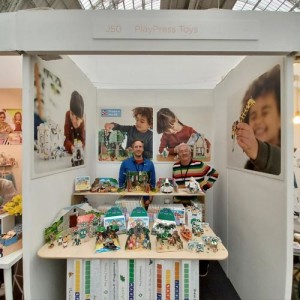 It was great to see PlayPress at the show as well. It is a relatively young company at the early stage of its development. It is focused on sustainably produced card construction kits that are made in the UK. Its licensed roster includes Dinosaur Roar, The Gruffalo and its most recent licence, Shaun the Sheep. Its products promote creative play and are cleverly developed. They are packaged in formats that make them giftable. Top Drawer seemed like the perfect trade show for them with its mix of retailers which include independents, heritage sites, booksellers and department stores.
It was great to see PlayPress at the show as well. It is a relatively young company at the early stage of its development. It is focused on sustainably produced card construction kits that are made in the UK. Its licensed roster includes Dinosaur Roar, The Gruffalo and its most recent licence, Shaun the Sheep. Its products promote creative play and are cleverly developed. They are packaged in formats that make them giftable. Top Drawer seemed like the perfect trade show for them with its mix of retailers which include independents, heritage sites, booksellers and department stores.
It is good to see an early stage company using licensing and finding success with their licensed products. PlayPress is also a family firm and it is nice to see another family firm joining the licensing fold.
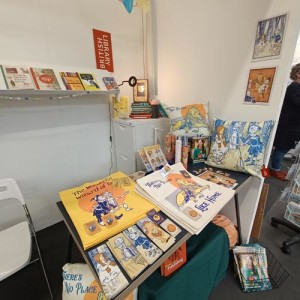 Thinking of the heritage category, it was interesting to see the British Library exhibiting at the show. It was showcasing its wholesale ranges which included The Wonderful Wizard of Oz and Alice in Wonderland.
Thinking of the heritage category, it was interesting to see the British Library exhibiting at the show. It was showcasing its wholesale ranges which included The Wonderful Wizard of Oz and Alice in Wonderland.
The British Library taps into its extensive archive collection to create the product range.
It also works with licensees and having a presence at Top Drawer helps build its profile for licensing. I am sure it is able to integrate licensed products into its wholesale offer and I guess a show like Top Drawer might help it to identify product gaps that licensees could fill.
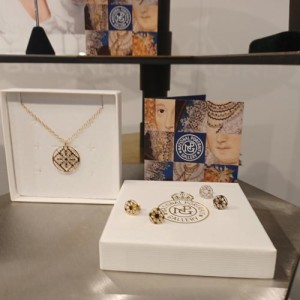 Heritage was a licensing genre that popped up in other places in the show including a lovely range of jewellery from Licensed to Charm, influenced by works of art from the National Portrait Gallery including portraits of Mary Herbert, Countess of Pembroke and Sir Walter Raleigh.
Heritage was a licensing genre that popped up in other places in the show including a lovely range of jewellery from Licensed to Charm, influenced by works of art from the National Portrait Gallery including portraits of Mary Herbert, Countess of Pembroke and Sir Walter Raleigh.
The portraits are stepping off points for Licensed to Charm’s creative work and, in a neat touch, the jewellery also includes notes about the artwork.
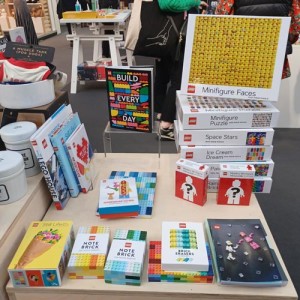 Books also seemed to have a strong presence throughout the show with a number of publishers and book wholesalers exhibiting.
Books also seemed to have a strong presence throughout the show with a number of publishers and book wholesalers exhibiting.
Abrams & Chronicle Books had a number of licensed book ranges on its stand. It is a US-based publisher with an international presence and distribution. Publishers are more adept at creating formats that work across a range of retailers including gift retailers and licensed brands help them achieve this. These include non-book products.
Highlights on the Abrams & Chronicle stand included a LEGO range that featured Note Bricks and jigsaw puzzles. Of course, LEGO is a global brand and one that fits in well to a diverse range of retailers.
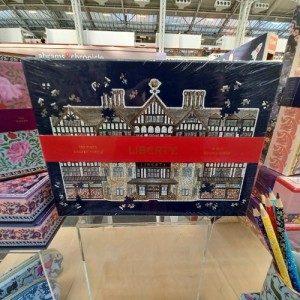 It also had a very attractive range of Liberty products including notebooks and notecards. A highlight product was a double-sided jigsaw featuring the iconic Liberty shop front. This range was really well presented and packaged. Again, Liberty is a brand with international appeal and one that works in a variety of settings. Interestingly, long-term licensee Portico has also dipped into the retail market to create a licensed range with Joules being a core part of their offer.
It also had a very attractive range of Liberty products including notebooks and notecards. A highlight product was a double-sided jigsaw featuring the iconic Liberty shop front. This range was really well presented and packaged. Again, Liberty is a brand with international appeal and one that works in a variety of settings. Interestingly, long-term licensee Portico has also dipped into the retail market to create a licensed range with Joules being a core part of their offer.
Another book highlight at the show were a couple of Peaky Blinders books from Quarto. It has published a Cookbook and a Cocktail book. These are good examples of how some creative thinking in publishing can make good use of high profile brands and help create book formats that work well beyond the bookshop.
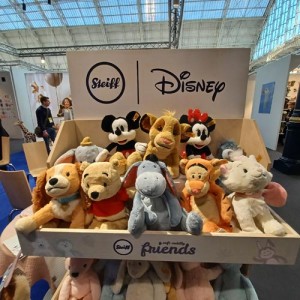 Steiff is a company that uses licensing in a very considered way, paying close attention to product development and preserving its premium position. It works closely with Disney and has developed a product range that works at different price points. It has recognised that it can engage with a broader group of retailers by developing lower priced products, but also ones that tap into emerging trends like pop culture.
Steiff is a company that uses licensing in a very considered way, paying close attention to product development and preserving its premium position. It works closely with Disney and has developed a product range that works at different price points. It has recognised that it can engage with a broader group of retailers by developing lower priced products, but also ones that tap into emerging trends like pop culture.
It is also open to working with emerging brands like Tonies. In this case, it has created an exclusive range of plush toys and characters with Tonies. It is interesting to see how a traditional brand like Steiff has been able to work with a contemporary tech brand like a Tonies. Steiff was also showcasing some of its brand extensions into the apparel area. Steiff is certainly a brand that doesn’t rest on its laurels.
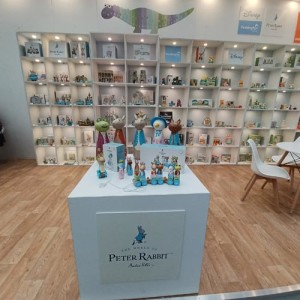 Peter Rabbit is a brand that seems to be able to operate in a range of categories successfully. I saw two Peter Rabbit ranges in quite contrasting categories at Top Drawer. New English Teas had a broad range of Beatrix Potter tea tins featuring classic artwork, while Orange Tree Toys has an extensive range of wooden toys which feature the characters in a more contemporary style. This is a range that has grown over the years and even includes musical instruments now.
Peter Rabbit is a brand that seems to be able to operate in a range of categories successfully. I saw two Peter Rabbit ranges in quite contrasting categories at Top Drawer. New English Teas had a broad range of Beatrix Potter tea tins featuring classic artwork, while Orange Tree Toys has an extensive range of wooden toys which feature the characters in a more contemporary style. This is a range that has grown over the years and even includes musical instruments now.
These two ranges are a great example of how a flexible approach to design can help build a licensing programme and also open up new categories. Furthermore it is worth noting how a category like gifting is an increasingly broad one that supports a mix of products.
Finally, it was great to see so many exhibitors proudly displaying the fact that they were Gift of the Year finalists. Gift of the Year is a great example of a trade body creating a focal point for its industry and creating momentum. Good luck to all the finalists.
Ian Downes runs Start Licensing, an independent brand licensing agency. His Twitter handle is @startlicensing – he would welcome your suggestions for what to look out for.































